CD V-750 Dosimeter Chargers (ca. 1954-1964)
The primary purpose of the Model CD V-750 was to charge civil defense dosimeters (CD V-138, 730, 740, and 742). By charge, we mean adjust the dosimeter so that the quartz fiber, visible through the eyepiece as a fine line running vertically across the scale, is set at zero. The CD V-750 could also be used to read the dosimeters if insufficient light was available—quite possible in an emergency situation.
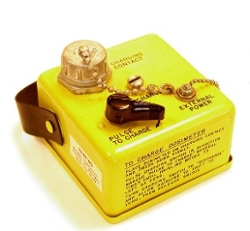
Bendix CD V-750 Model 1
The key features of the CD V-750 were the charging contact (protected by a dust cap attached to the case via a bead chain) and the control knob for adjusting the charge.
The Bendix charger Model 643 shown to the right is extremely early (ca. 1954-1956). While it is identified as a CD V-750, there is no model number. Nevertheless, it was referred to by the OCDM as the CD V-750 Model 1.
What is most interesting is the fact that the push lever towards the lower left is used to provide the charge. The mechanical energy generated by pumping the lever is converted into electrical energy. The unit does employ a battery, but only to power the light used to illuminate the dosimeter scale.
The case is relatively large (4.5" x 4.5" x 2.5") because it has a storage location for the battery when the unit is not being used.
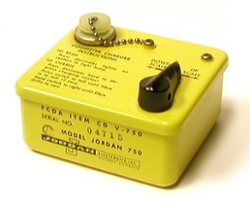
Jordan Electronics CD V-750 Model 2
The Bendix Model 1 was donated by the Federal Emergency Management Agency courtesy of Carl Siebentritt.
The Jordan Electronics, Inc. charger shown to the left is identified as a CD V-750. While there is no model number on it, the OCDM referred to it as the CD V-750 Model 2.
The Jordan Electronics Model 2 was donated by William Bashaw III.
The Universal Atomics Model 3 in the photograph below is a transistorized version of the 750. The case (ca. 4.5" x 4.5" x 2") is plastic. Since a Universal Atomics Model 3 with a later serial number appears in the Civil Defense Technical Bulletin TB-11-20 (revised June 1959), it is probably safe to say that this example dates from 1957-1959.
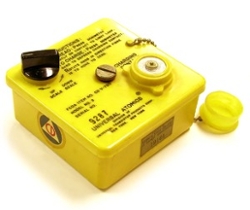
Universal Atomics CD V-750 Model 3
Since the Model 3 was also referred to in a January 8, 1959 OCDM Advisory Bulletin, it is safe to say that the Model 3 came along in 1957 or 1958. The manufacturer, Universal Atomics Corp., also made a commercial version, the UAC 750.
In September 1986, FEMA sent a notification to the maintenance and calibration facilities indicating that Models 1 - 3 of the CD V-750 were obsolete.
The Model 3, but not the Model 4, was referred to in a January 8, 1959 OCDM Advisory Bulletin. As such, the Model 4, if it existed, probably made its first appearance in 1959 or 1960.
Batteries: One 1.5 volt "D cell"
Manufacturers: Bendix Aviation Corp., Jordan Electronics, Universal Atomics, Industrial Electronic Hardware Corp.
Models: 1, 2, 3, 4, 5, 5a, 5b (the Model 6 is treated separately)
Number produced: Approximately 515,000
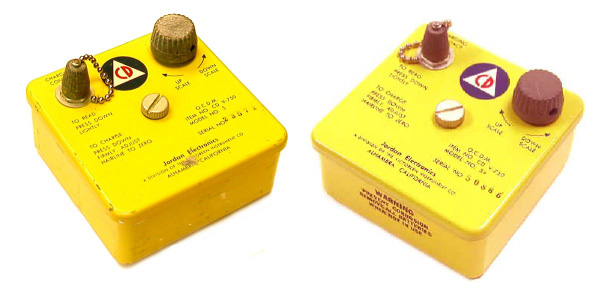
Jordan Electronics CD V-750 Model 5 (left) and 5a (right)
The photograph below left shows a CD V-750 Model 5b produced by Industrial Electronic Hardware Corporation, probably the most commonly encountered version of the CD V-750. The photo below right shows a Jordan Electronics CD V-750 Model 5b with a serial number of 001 stamped on the case.
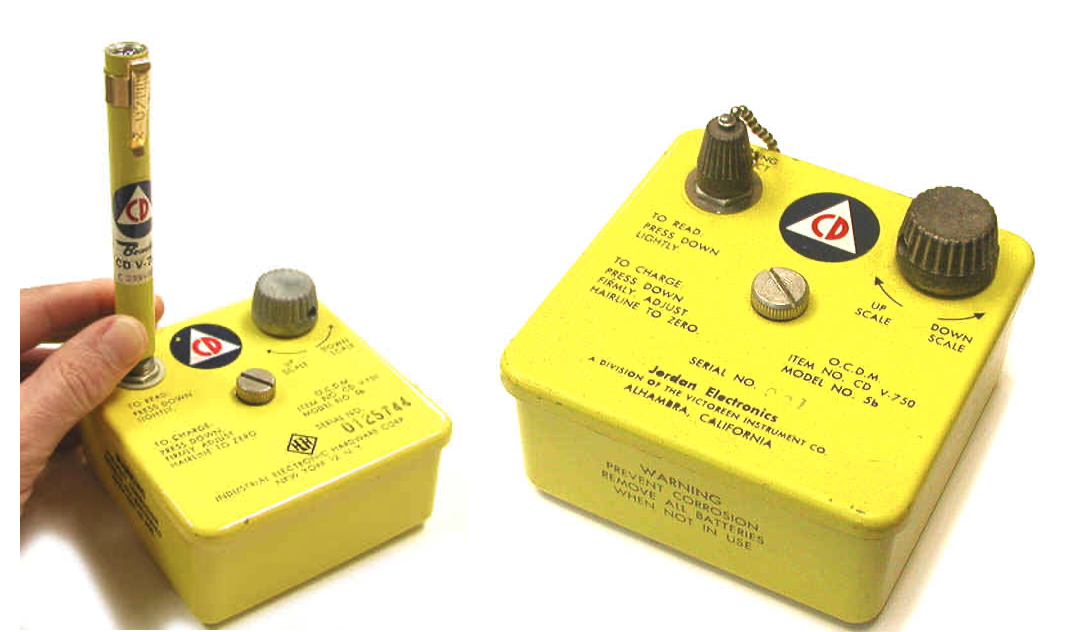
Jordan Electronics CD V-750 Model 5b
Estimated Dates of First Production:
- Model 1 ca. 1955
- Model 2 ca. 1956
- Model 3 ca. 1957, 1958
- Model 4 ?
- Model 5 ca. 1960
- Model 5a ca. 1961
- Model 5b ca. 1962
Approximate Cumulative Procurement, Inventory and Distribution of CD V-750s*
| Fiscal Year | Procured | Inventoried | Distributed |
|---|---|---|---|
| Through FY 1956 | 2,395 | 992 | |
| FY 1957 | 16,524 | 6,561 | |
| FY 1958 | 38,609 | 17,743 | |
| FY 1959 | 38,937 | 9,138 | 29,799 |
| FY 1960 | 38,937 | 1,134 | |
| FY 1961 | 137,703 | 95,958 | 41,745 |
| FY 1962 | 122,672 | 59,247 | |
| FY 1963 | 515,032 | ||
| FY 1964 | 515,032 | ||
| FY 1965 | 515,032 | 264,196 | 249,096 |
| FY 1966 | 515,032 | 227,803 | 287,218 |
| FY 1967 | 515,032 | 209,188 | 305,831 |
| FY 1968 | 515,032 | 183,265 | 331,699 |
| FY 1969 | 515,032 | 162,571 | 352,374 |
| FY 1970 | 515,032 | 136,956 | 378,423 |
| FY 1971 | 515,032 | 122,593 | 392,402 |
| FY 1972 | 515,032 | 112,154 | 402,838 |
| FY 1973 | |||
| FY 1974 | 515,032 | 17,220 | 497,772 |
*The numbers in the above table should be considered approximate. I compiled them from data in the Annual Statistical Reports of the OCDM, OCD and DCPA. By "procured," I mean delivered by the manufacturer to the OCDM, OCD or DCPA. "Inventoried" means stored in a Federal (rather than state) warehouse available for distribution. "Distributed" means sent to the end user. The latter primarily means the states, but also various federal agencies and even foreign governments. The number of procured instruments may be greater than the combined number of inventoried and distributed instruments for a variety of reasons: some may have been sent back to the manufacturer, some may have been disposed of, the numbers might be incorrect, etc.
References
- Civil Defense Technical Bulletin TB-11-20 Radiological Instruments for Civil Defense September 1955 (Revised June 1959).
- Office of Civil and Defense Mobilization. Interim Procedures for Maintenance of Radiological Instruments. Advisory Bulletin No. 229. January 8, 1959.
- Operating and Maintenance Instructions for the Jordan Model 750-5 Dosimeter Charger, no date.
- FEMA, Radiological Instruments: An Essential Resource for National Preparedness, CPG 3-1/September1986.
